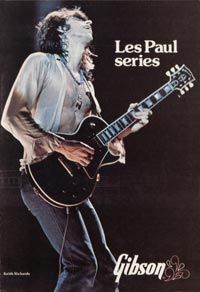
Les Paul was one of the most important figures in the history of modern day music. He was an inventor, an innovator in studio recording and an incredible guitarist. After his death, an auction of his guitars included dozens of projects with experimental electronics dating back decades.
But the best invention he was associated with was the Les Paul solid body guitar; probably the most recognised, and copied guitar design, alongside the Gibson SG and Fender Stratocaster and Telecaster. Les Paul certainly had input on the design, features and finish of the instrument, but the name on the original patent was that of Gibson president Ted McCarty.
Rickenbacker had had a solid body over twenty years before the launch of the Les Paul, and Fender and Bigsby had also recently produced solid bodies. Fender launched the Esquire and Broadcaster (which became the Telecaster) in 1950. There had been public demand for more conveniently sized solids for some time, and Gibson finally responded in 1952. McCarty wanted a guitar that would be better than the harsh-sounding 'junk' that Fender was producing. The Les Paul was to have a carved top and a set-neck - beyond the ability of Fender at the time. Gibson produced several mock ups, trying different woods, but ended with the mahogany body/maple top combination of their first solid body, the Les Paul Model. And what a success: with a small gap in the early 1960s, it has been in production ever since.

Just about every famous guitar player has played one, though it is particularly associated with Jimmy Page (Led Zeppelin), Eric Clapton (Cream), Peter Green (Fleetwood Mac), Keith Richards (Rolling Stones), Paul Kossoff (Free) and Slash (Guns and Roses). Keith Richards appeared on the cover of the 1975 Les Paul catalogue with an LP Custom.
The Les Paul came in several variations. The 'Les Paul Model' of 1952 had a Honduras mahogany body and neck, with a gold finished maple top (gold top). It was regularly upgraded throughout the 1950s, and many would argue that it was at its pinnacle in 1958. It had had two soap bar P90 pickups from 1952, however in late 57 they were replaced by standard Gibson humbuckers. Cherry sunburst became the standard colour rather than the goldtop, and to differentiate itself from the other Les Paul models, it was renamed the Les Paul Standard by about 1960.
The single pickup Les Paul Junior was launched in 1954. Once again this was a mahogany instrument, both body and neck, but without the carved maple tops of the other Les Pauls. It was the only model not to change its pickup to a humbucker in 1957. A limed-mahogany version was also available (at a slightly increased price, and was known as the Les Paul TV.
1954 also saw the first mention of the two pickup Les Paul Custom (the black beauty), which again started out with single coil pickups, but became a three humbucker model in '58. Beautifully appointed with gold hardware and split diamond headstock inlays contrasting the ebony (black) finish and matching ebony fretboard.
Specifications, original advertising, catalog pages and shipping data for the various incarnations of the Gibson Les Paul.
But in early 1961 the whole range was redesigned - it was given a new double cutaway body shape (today's SG). Early SGs were sold as 'Les Pauls'. For one reason or another, Les Paul did not approve, and his name was removed from these guitars. So briefly, in the early-mid 1960s Les Paul guitars were not available. However, a lot of the early guitar heroes mentioned above were discovering these great instruments, and finding them perfectly suited for the overdriven blues-rock scene that was emerging, particularly in the mid-sixties UK.
Public demand for Les Paul guitars precipitated a reissue in 1968; initially two models were made available again, the Les Paul Standard and Custom, and these guitars have been available ever since. They sold sufficiently well that further models were added in the late 1960s and throughout the 1970s, both in well-known and a myriad of lesser-known configurations. One of the first models was the mini-humbucker equipped Les Paul Deluxe, added to the line in 1969.
As well as being a great jazz guitarist, Les Paul was a guitar inventor, and amongst his designs were the low-impedance pickups designed largely for studio use. The Les Paul Professional, Personal, and Recording were developed by Les Paul himself, using some of the novel circuitry he had been experimenting with in his own studio. Low impedance pickups allow a cleaner signal when recording, however were not designed for normal amplified performances. This was not a problem, as the first two models came with a transformer for live work, and the recording guitar had a switchable transformer built in.
The Les Paul Special 55 was reissued in 1975, and the Les Paul Pro Deluxe, another guitar based on the 1950s models was first launched in 1978.
The late seventies saw big sales of the Les Paul, and a lot of newer models added to the line. Amongst the high-end Les Pauls were the Artist, Artisan and The Les Paul, each with custom features, top-of-the-range appointments and price tags to match.
$98000
$84900
$54000
$31900
$28000
$26400
$25695
$24900
$21500
$19500
$18000
$17999
$17995
$17000
$15500
$15000
$14900
$14500
$13999
$13995